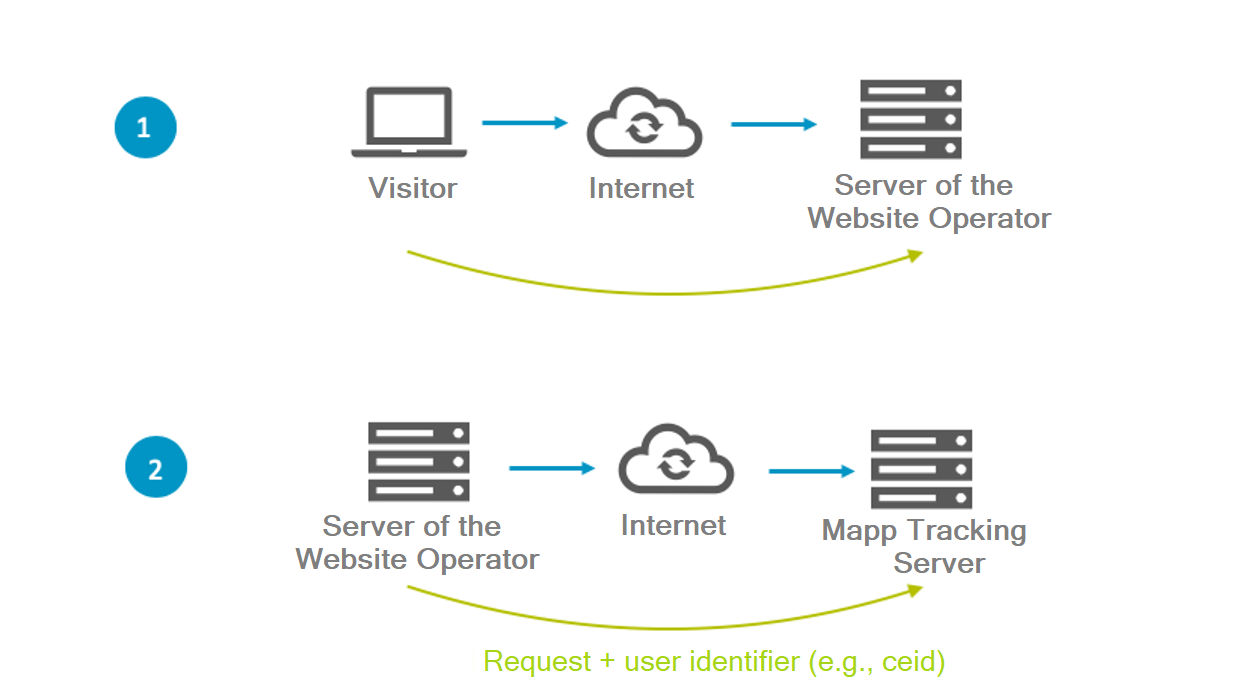Server-to-Server
With server-to-server tracking, data is transferred directly from the web server (of the website operator) not from the client to the Mapp Intelligence tracking server.
Once implemented in a web page the Mapp Intelligence JavaScript generates an image object that sends a request to the Mapp tracking system. Relevant information for the page is sent as URL parameters in this request. While additional information (referrer and user agent, browser language, cookies) is transferred in the browser's request header, the TCP/IP connection can make the IP address of the user available in the tracking system. Users without JavaScript send information to the tracking system via the URL of an image in the <noscript> area. The tracking system will then return a 1x1 pixel GIF image in the response. Also, cookies (only with activated third-party cookies) are sent in the response header.
Particularities of the URL-based tracking
- High data accuracy
- Tracking is not evident to visitors
- Tracking without cookies
- Direct testing on websites is not possible
Tracking Options
Tracking is generally done through direct communication between the visitor's browser and Mapp's tracking server. There are three options:
1. Synchronous Pass-Through without Tracking Script
In this case, no tracking JavaScript is used on the client side. Relevant information is provided by the site operator's server and sent to the Mapp tracking server. The response from the tracking system is addressed directly to the client. Although you have the advantage here that client-side JavaScripts do not influence the page display or behavior, on the other hand only a few basic information is available to you.
![]()
When retrieving a page from the server, the following information is transmitted:
- The IP address of the visitor
- Cookies in the request header
- Current page information through a request
- Referrer in the request header ("referrer")
- Browser recognition in the request header ("user agent")
Structure of the request to the tracking server
http://[Track-Domain]/[Track-ID]/wt?p=300,0,0,0,0, 0,0,[4]&X-WT-UA=[5]&X-WT-IP=[1]&X-WT-RQ=[3]2. Synchronous Pass-Through incl. Tracking Script
With this variant, the tracking script is used for the synchronous pass-through of information between the server of the site operator and the Mapp tracking server. On the client side, the tracking JavaScript is used. The requests from the tracking script go to the server of the site operator, which forwards the request to the Mapp tracking server and sends the response back from the tracking server to the client. The advantages here are that all key figures are available and the availability of the site operator defines the accessibility. A disadvantage, however, is that the additional tracking load may slow down the servers of the site operator.
![]()
The integrated Mapp Intelligence tracking script (pixel) retrieves a 1x1 pixel image from the server.
http://[track domain]/[track ID]/wt?p=300,...Additional information transferred:
- The IP address of the visitor
- Browser recognition in the request header ("user agent")
- Cookies in the request header ("cookie")
http://[track domain]/[track ID]/wt?p=300,... &X-WT-UA=[2]&X-WT-IP=[1]The tracking request is passed through and supplemented with additional information. Cookies [3] in the request header field "Cookie". Only the Mapp Intelligence cookies have to be sent. The response contains the header field "Set-Cookie" which is sent back to the client.
3. Asynchronous Pass-Through
With this variant, information is passed asynchronously from the server of the site operator to the Mapp tracking server: No tracking JavaScript is used on the client side. The requests from the tracking script go to the server of the site operator, which forwards the request to the Mapp tracking server. The server of the site operator generates a generic response for the client and does not wait for a result from the tracking server. The advantages are that there is no interference in the page display or behavior since no JavaScript is used on the client side. The availability of the site operator defines the accessibility, the server of the site operator does not have to wait for a response from the tracking server. The disadvantage is that there is only little necessary information available, in addition, there is the additional load on the server of the site operator.

When retrieving a page from the server of the website operator, the following information is transmitted:
- IP address of the visitor
- Current page through request
- Referrer in the request ("referer")
- Browser recognition ("user agent")
Structure of the request to the tracking server
http://[Track-Domain]/[Track-ID]/wt?p=300,0,0,0,0, 0,0,[3]&X-WT-UA=[4]&X-WT-IP=[1]&X-WT-RQ=[2]